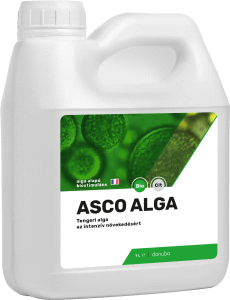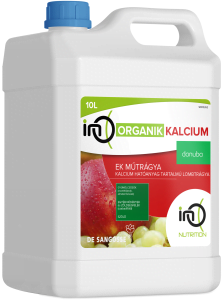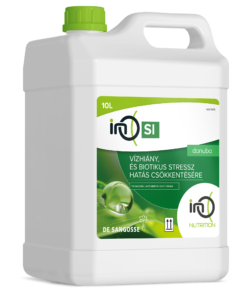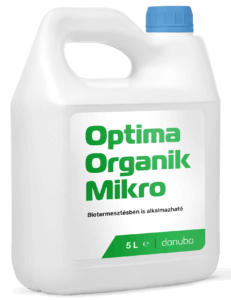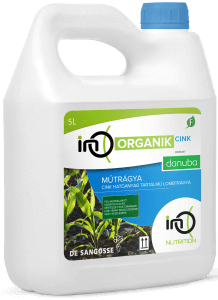Ino Organik Calcium
Dose: 2 dl/10 litres of spray juice
Please pay special attention to the dose and time of application (temperature, time of day) to avoid occasional scorching. Application on hot days should be avoided. Application above 22 degrees is not recommended. Clean the application equipment used before and after spraying with clean water.
What is it good for?
The foliar fertilizer also contains organic chelate to chelate the calcium cation in the product. This natural chelating agent improves the adherence and penetration of the foliar fertilizer into the leaf.
Thanks to Ino Organic Calcium's special manufacturing process (multiple filtration) and unique choice of raw materials, the product 100% is water-soluble and does not damage the fruit or leaves. Ino Organic Calcium is several times more effective than calcium applied to the soil.
For all our products, the manufacturer guarantees the germ count and active ingredient content for 36 months from the date of manufacture.
In stock
16.510 Ft
Calcium affects the following physiological processes: it regulates the structure, strength and permeability of cell membranes. In the absence of calcium, permeability increases, which can lead to too much nutrient leakage. It has a beneficial effect on root growth, helping the uptake of other nutrients. It also has a positive effect on cell elongation and differentiation.
The foliar fertilizer also contains organic chelate to chelate the calcium cation in the product. This natural chelating agent improves the adherence and penetration of the foliar fertilizer into the leaf. Thanks to Ino Organic Calcium's special production process (multiple filtration) and the unique choice of raw materials, the product 100% is water soluble and does not damage the fruit or leaves. Ino Organic Calcium is several times more effective than calcium applied to the soil.
 Available at
Available at
- Its use is mainly recommended in horticultural crops.
- In orchards (especially in apple orchards), it is recommended at a maximum concentration of 2 % 3-4 times during intensive fruit growth until the third week before harvest. It can also be used in apple orchards in bitter cultivation.
- In grapes, use before flowering (shoot growth) and at the time of bunch closure!
- For vegetable crops (especially tomatoes), continuous use every two weeks from the first set of crops is recommended.
- Typical application rates are 4-6 l/ha in no less than 400 litres of spray.
- Used alternately with Ino Potassium 500, both calcium and potassium supply can be maintained at optimal levels. Do not mix the two products!
Symptoms of calcium deficiency
Since calcium is transported upwards in the plant and is a nutrient with little mobility within the plant, it accumulates in the leaves, and mainly in the older leaves. Thus, calcium deficiency is mainly observed in young leaves. This is the exact opposite of the movement of potassium. The first signs of calcium deficiency can be seen mainly in young leaves. The leaves are usually smaller, deformed, with spoon-shaped tips and edges. Chlorosis occurs from the leaf edges, with brown spots forming on chlorotic leaves. The lesions are often preceded by browning of the veins in the still green leaf tissue. The leaves die back from the tip to the base.
In tomatoes and peppers, tip rot of the fruit can be observed, similar symptoms can also occur in watermelons and cucumbers In intensive apple cultivation, bitter pit is becoming more common on apples, which is partly already on the tree but in many cases only during storage. Bitter spot is the result of a calcium deficiency, which can be caused not only by a poor supply of calcium but also by an excess of potassium, magnesium or nitrogen. Excess nitrogen causes loose tissue. Bitter spot can also be expected in drought conditions, as the tree's roots cannot absorb calcium from dry soil. Apple varieties highly susceptible to calcium deficiency are Granny Smith, Braeburn, Yellow Newton, Jonathan, Golden Delicious (California), Gravenstein, Red Delicious, Baldwin, Boskoop, Cleopatra, Cox's Orange, Grimes Golden, Merton, Sturmer, Prima starking, Starkimson, Marigold, Northen Spy, York Imperial. Rome Beauty, Golden delicious (Canada), Macintosh, Haralson, Lobo, Winesap, Red gravenstein, Stonetosch, Gala, Fuji.
Calcium availability in soil
In soil solution, calcium is present as calcium chloride, calcium nitrate, calcium sulphate and, in alkaline soils, calcium bicarbonate. When calcium is taken up by plants from the soil solution, Ca2+ ions on the surface of the colloids are added to the solution and set the correct solution equilibrium. Calcium deficiency can be expected in acid soils. This may be increased below pH 5 It is good if calcium ions are mostly bound to the surface of soil colloids, up to 80% In active soil life (diverse and abundant microorganisms), carbon dioxide formed during organic matter decomposition dissolves calcium and magnesium carbonates. This also makes insoluble calcium and magnesium compounds more absorbable Calcium availability to the plant is also reduced if the soil is dry and the soil moisture does not provide sufficient nutrients







